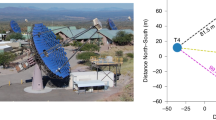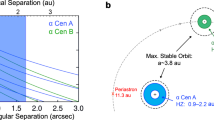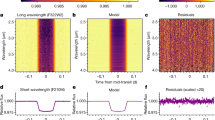Abstract
The detection and characterization of an Earth-like planet orbiting a nearby star requires a telescope with an extraordinarily large contrast at small angular separations. At visible wavelengths, an Earth-like planet would be 1 × 10-10 times fainter than the star at angular separations of typically 0.1 arcsecond or less1,2. There are several proposed space telescope systems that could, in principle, achieve this3,4,5,6. Here we report a laboratory experiment that reaches these limits. We have suppressed the diffracted and scattered light near a star-like source to a level of 6 × 10-10 times the peak intensity in individual coronagraph images. In a series of such images, together with simple image processing, we have effectively reduced this to a residual noise level of about 0.1 × 10-10. This demonstrates that a coronagraphic telescope in space could detect and spectroscopically characterize nearby exoplanetary systems, with the sensitivity to image an ‘Earth-twin’ orbiting a nearby star.
This is a preview of subscription content, access via your institution
Access options
Subscribe to this journal
Receive 51 print issues and online access
$199.00 per year
only $3.90 per issue
Buy this article
- Purchase on Springer Link
- Instant access to full article PDF
Prices may be subject to local taxes which are calculated during checkout


Similar content being viewed by others
References
Des Marais, D. J. et al. Remote sensing of planetary properties and biosignatures on extrasolar terrestrial planets. Astrobiology 2, 153–181 (2002)
Brown, R. A. Single-visit photometric and obscurational completeness. Astrophys. J. 624, 1010–1024 (2005)
Traub, W. A. et al. TPF-C: status and recent progress. Proc. SPIE 6268, OT1–OT14 (2006)
Kaltenegger, L. & Fridlund, M. The Darwin mission: search for extra-solar planets. Adv. Space Res. 36, 1114–1122 (2005)
Henry, C. et al. Terrestrial Planet Finder: architecture, mission design, and technology development. Proc. SPIE 5491, 265–274 (2004)
Cash, W. Detection of Earth-like planets around nearby stars using a petal-shaped occulter. Nature 442, 51–53 (2006)
Lyot, B. A study of the solar corona and prominences without eclipses. Mon. Not. R. Astron. Soc. 99, 580–594 (1939)
Guyon, O., Pluzhnik, E. A., Kuchner, M. J., Collins, B. & Ridgway, S. T. Theoretical limits on extrasolar terrestrial planet detection with coronagraphs. Astrophys. J. Suppl. 167, 81–99 (2006)
Born, M. & Wolf, E. Principles of Optics (Cambridge Univ. Press, New York, 2002)
Kuchner, M. J. & Traub, W. A. A coronagraph with a band-limited mask for finding terrestrial planets. Astrophys. J. 570, 900–908 (2002)
Kuchner, M. J., Crepp, J. & Ge, J. Eighth-order image masks for terrestrial planet finding. Astrophys. J. 628, 466–473 (2005)
Guyon, O. Phase induced amplitude apodization of telescope pupils for extrasolar terrestrial planet imaging. Astron. Astrophys. 404, 379–387 (2003)
Kasdin, N. J., Vanderbei, R. J., Littman, M. J. & Spergel, D. N. Optimal one-dimensional apodizations and shaped pupils for planet-finding coronography. Appl. Opt. 44, 1117–1128 (2005)
Vanderbei, R. J., Kasdin, N. J. & Spergel, D. N. Checkerboard-mask coronagraphs for high-contrast imaging. Astrophys. J. 615, 555–561 (2004)
Soummer, R. Apodized pupil Lyot coronagraphs for arbitrary telescope apertures. Astrophys. J. 618, L161–L164 (2005)
Riaud, P., Boccaletti, A., Baudrand, J. & Rouan, D. The four quadrant phase mask coronagraph. Publ. Astron. Soc. Pacif. 115, 712–719 (2003)
Trauger, J. T. et al. Coronagraph contrast demonstrations with the high-contrast imaging testbed. Proc. SPIE 5487, 1330–1336 (2004)
Trauger, J., Kern, B. & Kuhnert, A. TPF-C Technology Milestone #1 Report (JPL Document D-35484, Jet Propulsion Laboratory, Pasadena, 2006)
Borde, P. J. & Traub, W. A. High-contrast imaging from space: nulling in a low-aberration regime. Astrophys. J. 638, 488–498 (2006)
Heap, S. R. et al. Space Telescope Imaging Spectrograph coronagraphic observations of β-Pictoris. Astrophys. J. 539, 435–444 (2000)
Lowrence, P. J. et al. An infrared coronagraphic survey for substellar companions. Astron. J. 130, 1845–1861 (2005)
Krist, J., Trauger, J. & Moody, D. Studying a simple TPF-C. Proc. SPIE 6265, 3O1–3O11 (2006)
Trauger, J. et al. The Eclipse Mission: a direct imaging survey of nearby planetary systems. Proc. SPIE 4854, 116–128 (2002)
Acknowledgements
The speckle nulling algorithm is due to C. Burrows. Development of the HCIT facility is an ongoing activity. Experiments were designed and simulated with the computational models of D. Moody. The HCIT control system was developed by B. Gordon and A. Niessner. Recent speckle nulling runs in white light have been carried out by B. Kern. The optical alignments were carried out by F. Shi and A. Kuhnert. The DM was manufactured by Xinetics Inc. The coronagraph mask was fabricated under the supervision of D. Wilson at JPL’s Micro Devices Laboratory, on glass substrates supplied by Canyon Materials Inc. This work was carried out at JPL with the support of JPL and NASA.
Author Contributions J.T.T. performed HCIT experiments and data analysis at JPL; J.T.T. and W.A.T. co-wrote the paper.
Author information
Authors and Affiliations
Corresponding author
Ethics declarations
Competing interests
Reprints and permissions information is available at www.nature.com/reprints. The authors declare no competing financial interests.
Supplementary information
Supplementary Information
This file contains Supplementary Discussion, Supplementary Figures 1-2 with Legends, Supplementary Table 1 and additional references. (PDF 2207 kb)
Rights and permissions
About this article
Cite this article
Trauger, J., Traub, W. A laboratory demonstration of the capability to image an Earth-like extrasolar planet. Nature 446, 771–773 (2007). https://doi.org/10.1038/nature05729
Received:
Accepted:
Issue Date:
DOI: https://doi.org/10.1038/nature05729
This article is cited by
-
Coronagraph experiment on dark-hole control by speckle area nulling method
Optical Review (2015)
Comments
By submitting a comment you agree to abide by our Terms and Community Guidelines. If you find something abusive or that does not comply with our terms or guidelines please flag it as inappropriate.



